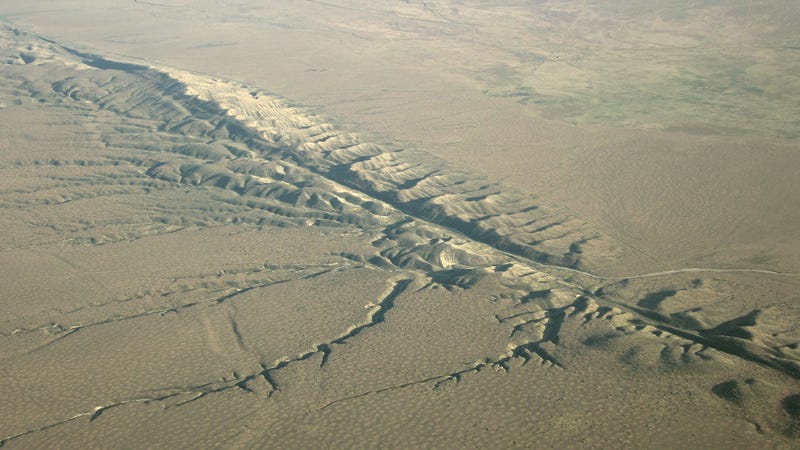A series of quakes under the Salton Sea may be a signal that the San Andreas Fault is on the verge of buckling. For the next few days, the risk of a major earthquake along the fault is as high as 1 in 100. Which, holy crap.
The United States Geological Survey has been tracking a series of earthquakes near Bombay Beach, California. This “earthquake swarm” is happening under the Salton Sea, and over 140 events have been recorded since Monday September 26. The quakes range from 1.4 to 4.3 in magnitude, and are occurring at depths between 2.5 to 5.5 miles (4 to 9 km).
For seismologists, these quakes could represent some seriously bad news. The swarm is located near a set of cross-faults that are connected to the southernmost end of the San Andreas Fault. Troublingly, some of these cross-faults could be adding stress to the San Andreas Fault when they shift and grind deep underground. Given this region’s history of major earthquakes, it’s got some people a bit nervous.
Calculations show that from now until October 4, the chance of a magnitude 7 or greater earthquake happening along the Southern San Andreas Fault is as high as 1 in 100, and as low as 1 in 3,000. On the plus side, the likelihood of it happening decreases with each passing day. These estimates are based on models developed to assess the probabilities of earthquakes and aftershocks in California.
“Swarm-like activity in this region has occurred in the past, so this week’s activity, in and of itself, is not necessarily cause for alarm,” cautions the USGS.
That being said, this is only the third swarm that has been recorded in this area since sensors were installed in 1932, and it’s much worse than the ones recorded in 2001 and 2009. This particular stretch of the San Andreas Fault hasn’t ruptured since 1680, and given that big quakes in this area happen about once every 150 to 200 years, this fault line is considerably overdue.
A big fear is that the rupturing of the southern portion of the San Andreas fault could cause a domino effect along the entire stretch, cracking the fault from Imperial County through to Los Angeles County. Another possibility is that the Salton Sea swarm could cause the nearby San Jacinto fault system to rupture,which would in turn trigger the collapse of the San Andreas Fault.
Should the Big One hit, it won’t be pretty. Models predict a quake across the southern half of California with a magnitude around 7.8. Such a quake would cause an estimated 1,800 deaths, 50,000 injuries, and over $200 billion in damage.
But as the USGS researchers point out, this is far from an inevitability. The swarm under the Salton Sea may subside, or fail to influence the gigantic fault nearby. Moreover, the estimates provided by the scientists are exactly that—estimates. The science of earthquake prediction is still very much in its infancy, and these models are very likely crunching away with insufficient data. No need to panic just yet.
A quake swarm in the Salton Sea that lasted over 24 hours from Monday into Tuesday has created a short-term increase in the risk of waking up the San Andreas fault.
“A swarm is when you have, in a tight geographic region, a cluster of earthquakes happen in rapid succession," says Kate Scharer, a research geologist with the U.S. Geological Survey. "It’s an area that often just has generic background seismicity but, for some reason, sort of pipes up for a while and lets off earthquakes.”
By the time all was said and done, over 200 earthquakes had been recorded in the more than day-long period.
The reason, Scharer says, is because the quake swarm happened below the southernmost tip of the San Andreas fault, an area that hasn’t produced a quake since 1680. They say that the odds of a magnitude-7 quake or larger happening in the southern area of the fault is as high as 1 in 100 and as low as 1 in 3,000.
“That’s related to the general statistics of how these swarms happen," says Scharer. "Some of the folks at the USGS collect data on this type of behavior, the swarm behavior, and then try to understand and model what you can expect from the future. So, in general, they would have similar forecasts, given that the magnitude distribution is fairly similar.”
The good news is that these odds decrease over time, but researchers say that it’s still a real enough risk to worry, and that a quake swarm like the one earlier this week are worth watching because, as Scharer notes, these smaller quakes could be what sets off a larger quake along San Andreas.
“Worldwide, you can see lots of cases where you have an earthquake on a subsidiary fault that’s not on the main strand that then is followed in short order by a larger rupture. The earthquakes that they had in Christchurch in New Zealand happened this way, or in kind of a bigger way, the Denali Fault rupture was kind of like that. We know that there’s some transfer of stress from these faults onto the main San Andreas due to their orientation, so there is some communication between them.”
Seismologists say the San Andreas fault is long overdue to rupture since a large-scale quake happens in the area every 150-200 years.



Δεν υπάρχουν σχόλια:
Δημοσίευση σχολίου
NO COMMENTS!